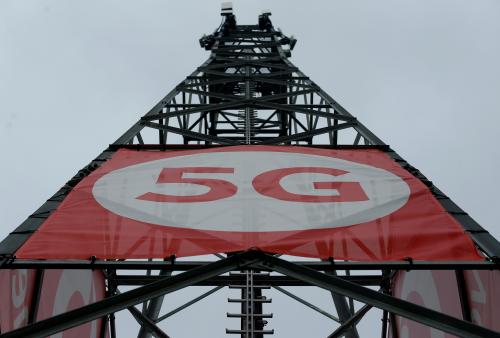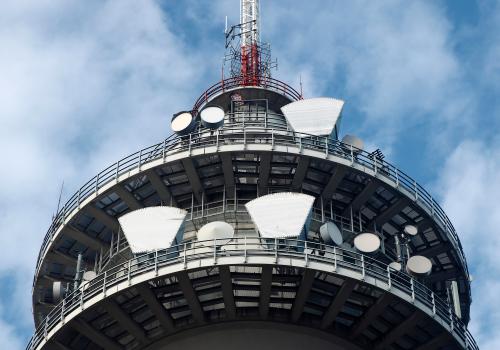In February 2009 the Federal Communications Commission began to draft a National Broadband Plan (NBP). Published in March 2010, the study asked how policymakers might improve broadband in the U.S.
The answer: use innovative market mechanisms to nudge more spectrum into the wireless sector. Cellular networks were exploding in popularity, hosting apps like Facebook and YouTube, and their capacities were being severely strained by the emerging mobile data tsunami. Yet, vast bandwidth was locked up under rigid allocations laid out for the technologies of yesteryear. More permissive rules would allow those frequencies to accommodate emerging networks and fuel robust competition in the mobile market.
The Plan emphasized the need for speed, not just in broadband but in administrative processing. Spectrum allocations had historically taken six to thirteen years, the study found. That was a drag on progress and a disincentive to entrepreneurship: no spectrum, no wireless invention.
One band, two auctions
The NBP’s crown jewel was its call to deliver 300 megahertz for mobile applications by 2015, increasing bandwidth by more than half. A two-sided auction would reallocate 120 MHz of that total from TV broadcasting, where it sat largely idle following the shift in video delivery to cable and satellite. The approach combined a “reverse auction,” wherein TV stations would state the prices at which they would agree to sell their licenses back to the government, with a “forward auction” for licenses allotted the airwaves reclaimed from broadcasting. In between, FCC engineers would reshuffle TV station channel assignments to create contiguous blocks of frequency spaces for the new licenses. The bids paid to the government in the “forward” auction would cover the buy-back offers made in the “reverse” auction.
The FCC dubbed this a “Voluntary Incentive Auction,” a term of strategic marketing import. For decades, FCC regulators had lived in fear of evicting wireless incumbents in general and TV broadcasters with clout in Congress in particular. The revolutionary idea was to allow payments to entice cooperation, much like a market transaction.[1]
But the NBP’s embrace of a spectrum liberalization program was a master stroke. From 1996 until 2006 there was no major release (by auction or otherwise) of mobile bandwidth despite wireless soaring to mass market popularity. Key FCC auctions conducted in 2006 and 2008 fed a starving mobile sector, but they took years to unfold. For example, the 1997 Budget Act had called for revenues from the licenses sold in 2008 to be counted as money in the bank by the year 2000. Auction dates were cancelled at least six times.
The National Broadband Plan report steered the discussion to wireless while grasping for better tools. It foresaw that hectoring broadcasters to “give up their seats” would likely see Congress block the eviction. So it executed the Incentive Auction, enabled by a congressional statute obtained in the Middle Class Tax Relief and Job Creation Act of 2012 that allowed money to pass through from mobile license bidders to TV stations. In March 2016, the formal auction started.
The FCC did well to push TV spectrum reallocation, but the detailed, highly structured process was buffeted by serious administrative costs. In the event, regulators missed their own marks: the 2010 NBP called for making TV spectrum available for mobile applications by 2014-15, but today’s reallocation is scheduled to conclude around 2020. Of the 120 MHz targeted, only 70 MHz was procured.
|
Stages of the FCC “Incentive Auction” (March 2016 to April 2017)
|
||||
| Total TV Bids ($B) | Total Mobile License Bids ($B) | Mobile MHz Offered | Auction Result | |
| Stage 1 | 86.4 | 22.5 | 100 | Fail |
| Stage 2 | 56.5 | 21.5 | 90 | Fail |
| Stage 3 | 40.3 | 19.7 | 80 | Fail |
| Stage 4 | 10.1 | 19.8* | 70 | Success |
* Includes bids for a final “assignment phase” specifying the frequencies for each license.
The broadband plan did succeed in nudging significant bandwidth into higher valued uses, and did so by (mostly) voluntary means. Broadband markets will benefit as 4G improves and 5G deploys. Yet, the regulatory quagmire continues.
In five years, less than half of the promised 300 MHz in the NBP was made available to the market. The big-ticket item, the Incentive Auction, will free less than a quarter of the 294 MHz (49 channels, 6 MHz each) set aside in today’s TV Band. More than 200 MHz of prime radio waves will continue to languish in an allocation dating to 1939. And the statute that gave the FCC authority to conduct the Incentive Auction granted regulators just one such opportunity – the emancipation campaign, as per that battle mode, is spent.
Other market mechanisms
Additional market-based mechanisms exist to reallocate spectrum: overlay rights. They should now be deployed to liberate the remainder of the TV Band, and much else.
Overlays vest existing licensees with the rights they currently enjoy.[2] They then convey new rights giving overlay owners primary control (with liberal use rights) over any unoccupied channels and secondary rights to access the channels assigned to incumbents. (“Secondary” means that the overlay licensee has an exclusive right conditional upon obtaining permission from the current licensee.) Because spectrum rights in adjacent spaces are highly complementary – controlling access to 20 MHz of contiguous frequency space is much more valuable than rights for equivalent bandwidth sliced up into pieces across multiple bands – the overlay is crucial in reconfiguring adjacent blocks of valuable spectrum.
In particular, incumbents may trade their rights to a buyer eager and able to consolidate its band. Cooperation blossoms, as shifting spectrum yields profits to be split among the overlay owners and existing licensees that create them. Tools used in competitive markets – venture capital or private equity funding, partnership agreements, bidding consortia – can be deployed to uproot the past and unleash the future.
Overlays do not require congressional authorization, complex auction designs, or contentious uprooting of incumbents. They delegate key aspects of spectrum reallocation to private markets, supporting them with a platform for cooperation. They are off-the-shelf regulatory tools, used in Personal Communications Services (1990s), Advanced Wireless Services (2000s), and elsewhere. They work – and we’ve got two-thirds of a TV band left to liberate.
[1] The idea to allow money-based re-allocations had been discussed since the 1950s and had been most effectively articulated by Ronald Coase whose thinking on the subject of airwaves disrupted conventional wisdom on the theory of externalities, winning him the Nobel Prize in Economics. The idea had specifically been applied to broadcast TV frequencies in Thomas W. Hazlett, The U.S. Digital TV Transition: Time to Toss the Negroponte Switch, AEI-Brookings Joint Center Working Paper No. 01-15 (Nov. 30, 2001); Evan Kwerel & John Williams, A Proposal for Rapid Transition to Market Allocation of Spectrum, Federal Communications Commission OPP Working Paper No. 38. (Nov. 15, 2002).
[2] For a description, see Thomas W. Hazlett, Optimal Abolition of FCC Allocation of Radio Spectrum, 22 Journal of Economic Perspectives (Winter 2008), 103-28.






Commentary
FCC “Incentive Auction” marks progress and pitfalls towards freeing wireless spectrum
May 24, 2017